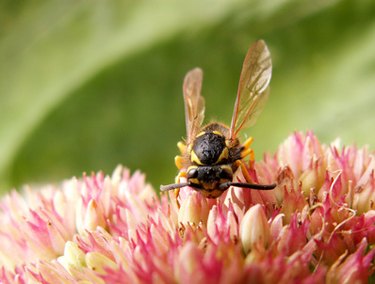
Species of wasps in Oklahoma that pose a stinging hazard include paper wasps and yellowjackets. Beneficial wasps that prey on garden pests include braconid, chalcid and ichneumon. Avoid stings by avoiding areas that attract wasps: sweet-scented products, garbage, bright-colored clothing and grounds with fallen fruit.
Paper Wasps
Video of the Day
Paper wasps are common in Oklahoma and measure 3/4 to 1 inch with slender yellow, black, brown or red bodies. They make paper nests by chewing wood or plants with saliva. Paper nests cling to trees, shrubs and manmade structures.
Video of the Day
The maximum colony size is 20 to 75 adults. A colony begins in spring, and progresses in summer when humans are most vulnerable to stings. Most wasps, however, are male, which cannot sting.
Beware of swarms that can develop on high structures. If you disturb a nest, run away from the swarm. Control a nest by applying an aerosol "wasp spray" at night.
Yellowjackets
Yellowjackets wear yellow and black bands on the abdomen. Three species in Oklahoma include Southern yellowjacket, Eastern yellowjacket and baldfaced hornet. Southern and Eastern yellowjackets form mature colonies of 1,000 to 5,000 adults. In contrast, the baldfaced hornet has mature colonies of 200 to 700 adults.
More aggressive than paper wasps, the yellowjackets defend colonies and nest entrances. Keep lawn mowers and trimmers away from the colonies, which are sensitive to rapid motion. These colonies remain active until late autumn. A wasp can repeatedly sting without losing its stinging apparatus. Prey includes live insects.
Stay away from garbage at picnic and recreation areas, food-processing and meat-packing plants, and all feeding grounds where wasps scavenge for protein and sugars.
Braconid
Tiny, stout braconid wasps measure from 1/16- to 5/16-inch. Sporting a dark appearance, some wasps have colored markings. This wasp can parasitize aphids, tent caterpillars, garden webworms, army worms, tomato hornworms and strawberry leaf rollers.
Chalcid Wasp
The chalcid (superfamily Chalcidoidea) includes from 22,000 up to 100,000 species of small, parasitic wasps. The chalcid wasp measures 1/64- to 5/16-inch. Distinctive from other wasps, the chalcid wasp does not fold its transparent wings.
The chalcid wasp feeds on nectar and fluids from animal wounds. As pest control, they act as parasites of cabbage loopers, cabbage worms, caterpillars, corn borers, corn earworms, codling moths, armyworms, cutworms and webworms.
Ichneumon Wasp
Ichneumon wasps are part of the superfamily Icheumonoidea, which may include over 80,000 different species. Ichneumon wasps measure the largest of the parasitic wasps with an adult length of 1/8- to 1 1/2-inches. With a black to yellowish slender body, this wasp has long antennae. Females have a long tail-like tube, the ovipositor, for egg laying. The ovipositor can act as a bore to place eggs. The female locates a host, then lays an egg close to or on the host. The developing larvae then feed on that host externally or internally. When ready to pupate, the wasp kills the host.
Several beneficial species prey on garden pests such as caterpillars, cutworms, corn earworms and white grubs.
- Oklahoma Cooperative Extesion Service EPP-83-5: Paper Wasps, Yellowjackets, and Other Stinging Wasps
- National Gardening Association: Parasitic Wasps Oklahoma City OK
- Ants Sawflies Bees and Wasp: Hymenoptera-Potter Wasp (eumenes Fraternus): Species Accounts
- Oklahoma Poison Control Center: Oklahoma's Creepy Critters